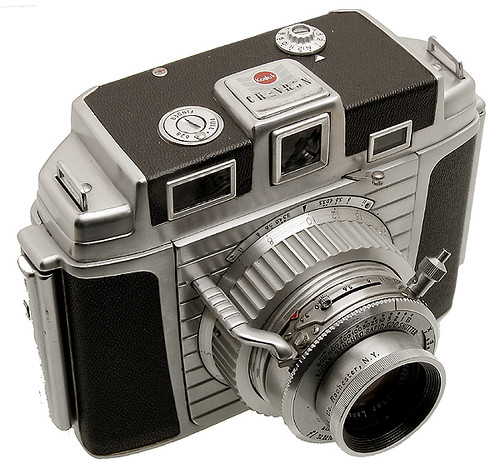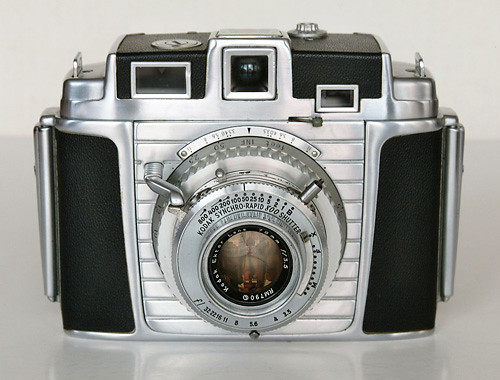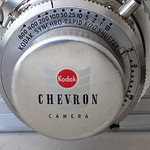Difference between revisions of "Kodak Chevron"
m (changed from user to cw pool) |
|||
| (11 intermediate revisions by 4 users not shown) | |||
| Line 1: | Line 1: | ||
| − | |||
| − | |||
| − | |||
| − | |||
{{Flickr image | {{Flickr image | ||
| Line 8: | Line 4: | ||
| image= http://farm2.static.flickr.com/1101/1383248623_738f7ee229.jpg | | image= http://farm2.static.flickr.com/1101/1383248623_738f7ee229.jpg | ||
| image_align=right | | image_align=right | ||
| − | | image_text= [[Kodak]] Chevron | + | | image_text= [[Kodak]] Chevron |
| + | |image_by=Rick Soloway | ||
| + | |image_rights=wp | ||
}} | }} | ||
| + | The '''Kodak Chevron''' is a 6×6cm coupled-rangefinder leaf-shutter camera for [[620 film]]. Much like its more popular predecessor, the [[Medalist]], it is a higher-end member of the [[Kodak]] 620 camera family. It is equipped with a four-element 78mm Ektar with maximum aperture of f/3.5 and an impressive (for a leaf shutter) top shutter speed of 1/800 of a second. The shutter is an unusual design in which the metal blades rotate 180 degrees when being cocked and again when firing. This means that the shutter would expose the film while being cocked, so a secondary shutter protects the film during cocking. This design is apparently unique to the Chevron. | ||
| + | |||
| + | An 828-format (non-perforated 35mm) adapter came with the camera originally and the finder adjusts appropriately. The viewfinder adjusts for parallax, there is a separate finder for the rangefinder. The automatic exposure counter is driven by a toothed roller next to the supply spool. It has a hinged back that can be opened from either side and also removed completely. | ||
| + | |||
| + | The Camera was made in Rochester between 1953-56 and is of an extremely durable and heavy aluminium construction. It sold for $215 in 1953. | ||
| + | |||
| + | |||
| + | {{Flickr_image | ||
| + | |image_source= http://www.flickr.com/photos/90900361@N08/28833151130/in/pool-camerawiki | ||
| + | |image= http://farm9.staticflickr.com/8459/28833151130_a79c155d6f.jpg | ||
| + | |image_align= left | ||
| + | |image_text= | ||
| + | |image_by= Geoff Harrisson | ||
| + | |image_rights= wp | ||
| + | }} | ||
| + | {{Flickr_image | ||
| + | |image_source= http://www.flickr.com/photos/90900361@N08/34898144151/in/pool-camerawiki | ||
| + | |image= http://farm5.staticflickr.com/4228/34898144151_351fb9a6c8_q.jpg | ||
| + | |image_align= left | ||
| + | |image_text= Lens cap | ||
| + | |image_by= Geoff Harrisson | ||
| + | |image_rights= wp | ||
| + | }} | ||
| − | + | {{br}} | |
| − | + | ==Links== | |
| + | *[https://sites.google.com/site/harrissonphotographica/home/kodak-chevron Chevron article by Geoff Harrisson] | ||
| + | |||
| + | [[category:Kodak|Chevron]] [[category:620 film]] [[category:6x6 rangefinder]][[Category:1953]] | ||
Revision as of 21:15, 30 August 2018

|
| Kodak Chevron image by Rick Soloway (Image rights) |
The Kodak Chevron is a 6×6cm coupled-rangefinder leaf-shutter camera for 620 film. Much like its more popular predecessor, the Medalist, it is a higher-end member of the Kodak 620 camera family. It is equipped with a four-element 78mm Ektar with maximum aperture of f/3.5 and an impressive (for a leaf shutter) top shutter speed of 1/800 of a second. The shutter is an unusual design in which the metal blades rotate 180 degrees when being cocked and again when firing. This means that the shutter would expose the film while being cocked, so a secondary shutter protects the film during cocking. This design is apparently unique to the Chevron.
An 828-format (non-perforated 35mm) adapter came with the camera originally and the finder adjusts appropriately. The viewfinder adjusts for parallax, there is a separate finder for the rangefinder. The automatic exposure counter is driven by a toothed roller next to the supply spool. It has a hinged back that can be opened from either side and also removed completely.
The Camera was made in Rochester between 1953-56 and is of an extremely durable and heavy aluminium construction. It sold for $215 in 1953.

|
| image by Geoff Harrisson (Image rights) |

|
| Lens cap image by Geoff Harrisson (Image rights) |